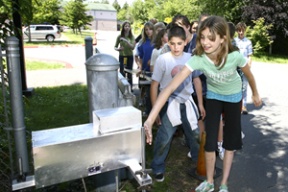Scientists look at school bus emissions, give students a lesson in enviromental study.
Some head for the beach.
But for their summer vacation, three scientists are studying a series of sooty hacks coming from the tailpipes of school buses at Woodward Middle School.
“This is the most exciting part of our day,” said Melissa Provinsal, with a touch of sarcasm, as yellow buses rumbled by an array of instruments at the school’s north entrance.
Under the tutelage of University of Puget Sound chemistry professor Dan Burgard, Provinsal and fellow UPS student Jamie Virginia spent the week measuring school bus emissions there.
Along with gaining some undergraduate research experience, their goal is to compare emissions from Bainbridge school buses – which have received various alterations aimed at cutting down pollution from diesel fuel – with unaltered school buses on Vashon Island.
Besides being harmful to the environment, diesel fuel exhaust contains fine particles that, when inhaled repeatedly, can aggravate asthma and allergies or cause other serious health problems like cancer, according to the U.S. Environmental Protection Agency.
There are two main technologies for reducing diesel fuel emissions.
Diesel particulate filters (DPF’s), which physically trap soot as it is expelled from the vehicle, are more expensive – as much as $8,000 – and typically are the solution for buses built before 2000. Once installed, DPF’s can reduce particulate pollution by up to 99 percent.
Newer buses often are equipped with diesel oxidation catalysts (DOC’s), which break down pollutants into less harmful components. At a cost of about $1,200, DOC’s reduce particulate matter by about 40 percent.
At the behest of the state Legislature, the Clean School Bus Program committed to more than $25 million in funding to retrofit 7,500 diesel school buses – about 75 percent of the school buses in the state – between 2003 and 2008.
The program is one of the largest state-funded, voluntary school bus retrofit programs in the country, according to the Puget Sound Clean Air Agency, one of its main supporters.
Bainbridge was among the first districts in the state to sign on by retrofitting 10 buses in 2004. Now all 32 Bainbridge school buses are “green,” said district spokesperson Pam Keyes.
The district also began using ultra-low-sulfer diesel fuel in 2003, three years ahead of the EPA requirement to do so.
Burgard, who has studied emissions all over the world, said Bainbridge is among the most successful examples of green buses in the state, which is why he brought his research team here.
But while much is known about the ability of current technologies to reduce the emission of particulate matter, or smoke, Burgard said less is known about their effectiveness in reducing the emission of harmful gasses, in particular mono-nitrogen oxides, also known as NOx.
Because power plants emit large amounts of nitrogen oxide, a main ingredient in smog, technologies aimed at reducing NOx emissions have been developed.
But those technologies have yet to be transferred to diesel-powered vehicles, Burgard said, which means that, for now, scientists can only hope that current technologies are at least having some impact on NOx emissions.
“Extensive research has been done in controlled environments,” he said. “But it’s different when you measure the emissions of a vehicle in the real world that’s accelerating and turning and running the air conditioning.”
Bus schedule
Aiming to do the latter, the trio set up Monday at Woodward, near the greatest concentration of school bus action in the district, and held their post through yesterday afternoon.
Emissions were measured during both the morning and afternoon commutes, when between 15 and 20 buses pull in and out of the driveway. They were taken via an ultraviolet and infrared light beam projected across the entrance.
Though the equipment used by the team is complex, the idea behind it is fairly straightforward: pollutants, spewed from passing vehicles, absorb to varying degrees the light of the projected beam.
By measuring how much light is absorbed, scientists can determine the concentration of pollutants coming from a vehicle’s exhaust. The group also used sensors to determine the speed of passing buses.
All measurements were automatically recorded by a computer in the back of the team’s van, for interpretation at a later date.
Meanwhile, Provinsal and Virginia recorded by hand the approximate number of students on each bus and which way the vehicle turned as it entered or exited the school, along with several other variables that could impact the results.
When they weren’t taking measurements, the group was engaging students from Woodward and neighboring Sakai Intermediate School. Burgard went to 11 classrooms during the week, each time giving a short lecture before bringing students outside to show them the equipment.
To demonstrate the speed detecting equipment, students took turns sprinting past the sensors, with arms raised overhead or tucked at their sides to avoid confusing the equipment with too much movement (for the record, the average Sakai student on Thursday ran at an average speed of about 11 miles per hour).
Despite the attention from students and curious onlookers, the team admitted there were lulls during the day.
As he slowly rolled by, one bus driver even joked through his window that the trio should set up a barbecue to pass the down time.
But Virginia said they’ll soon be busy enough. Measurements on Vashon Island begin next week. Then they’ll begin sifting through the long log of numbers.
“We’ll be interpreting data this summer,” she said. “All summer.”



